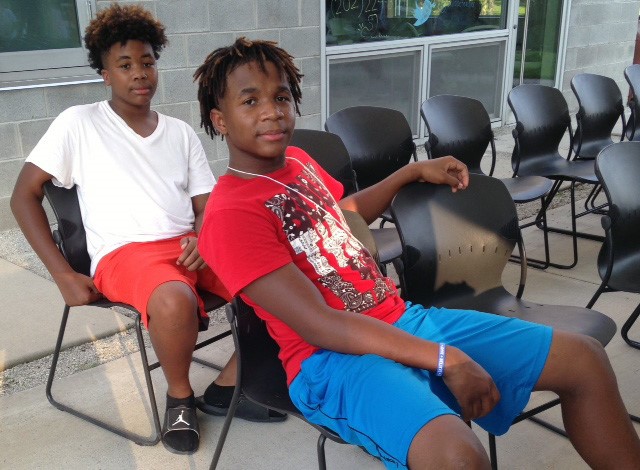The Hechinger Report Trevion Williams (left) and Jashun Griffith (right), both 13, students at Crystal Springs Middle School in Crystal Springs, Mississippi, chat at the Haley Farm lake gazebo. (Avis Thomas-Lester,The Hechinger Report)
Trevion Williams (left) and Jashun Griffith (right), both 13, students at Crystal Springs Middle School in Crystal Springs, Mississippi, chat at the Haley Farm lake gazebo. (Avis Thomas-Lester,The Hechinger Report)
CLINTON, Tenn. — Mississippi teenagers Jashun Griffith and Trevion Williams know more than the basics about their state’s civil rights history, but they said they didn’t learn most of what they know in school.
Instead, they gleaned their knowledge of topics such as the murder of 14-year-old Emmett Till and the March on Washington from reading books and searching the web. So when they heard about a week-long program in Tennessee’s Appalachian foothills that would teach them about the Civil Rights Movement of the past and how it connects to the social justice struggle of today, they were eager to attend.
Jashun and Trevion, both 13 and students at Crystal Springs Middle School, in Crystal Springs, Mississippi, about 30 miles south of Jackson, were among a dozen students and several chaperones who boarded buses in Jackson this summer and traveled to the Alex Haley Farm, outside of Knoxville, named for the late Pulitzer Prize-winning author who spurred legions of blacks to research their African roots after documenting his own.
They were among 450 students, teachers, preachers, child advocates and social justice activists from across the country who gathered for the Children’s Defense Fund’s 23rd Annual Samuel DeWitt Proctor Institute for Child Advocacy Ministry. The theme of the five-day event was “Hope for Our Future: From Weeping to Working for Justice for Our Children.”
The students’ experience was part summer camp, part church retreat, part activist organizing conference and part history mini-course. Several referred to the event as “civil rights camp.”
The Mississippi students’ mission was to absorb all they could about today’s struggle for justice and how employing new tactics — along with some from yesteryear — would help them forge change, just as other young people did all those years ago.
“These children should know this history, but they don’t,” said Anne Johnson, of Jackson, who taught high school English in Mississippi classrooms for 30 years. She first brought students to the Proctor Institute in 2008. Johnson endeavored to fill a knowledge gap by helping to implement The Great Migration Project at Jackson’s Lanier High School while she was still teaching. The project called for students to research and write about migration patterns of African Americans who left Mississippi.
“They don’t get much of [the state’s civil rights history] in schools,” she said. “Many of their parents either don’t know the history or don’t teach it to them. Some of them get it in church, but a lot of them don’t, which is surprising, considering how active churches in Mississippi were in the movement. Coming here is about bringing them to a place where they are exposed to that history, grassroots [organizing] and spirituality and how those things were intertwined in the Civil Rights Movement.”
Mississippi State Sen. David L. Jordan, a Democrat and a member of the Senate’s Education Committee, co-sponsored a bill that mandated a new civil rights strand in the state’s social studies standards. The bill was passed into law in 2006 and became effective in 2011. Some teachers complain that there is no curriculum for the new strand. Others say they are so busy focusing on helping students pass standardized tests that little time is left for such instruction.
Jordan believes many teachers simply don’t believe the history is important.
“There’s a new breed of teachers now who came up after all the changes that resulted from the Civil Rights Movement,” said Jordan, a retired science teacher. “They don’t see a need to bring up discrimination or to discuss with children what the struggle was back then. But it should be taught. These kids need to know this history. It was important and it would show them how important their state was in this movement. That is an empowering message for young people.”
Bob Moses, a revered leader among activists in Mississippi in the 1960s, said he saw little of that era’s history included in lessons in any classes when he taught math at Jackson’s Lanier High School from 1996-2006. Moses is the creator of the Algebra Project, which has been used in several states to bolster learning for educationally disadvantaged children.
Moses said young people need to know that he and his colleagues fought against many of the same wrongs that activists are opposing today: police brutality against young black men; inequitable educational opportunities for minority and poor children; unemployment and underemployment of men of color; and threats to voting rights.
The Proctor Institute was conceived by the Rev. Shannon Daley-Harris, former director of religious affairs for the Children’s Defense Fund (CDF), and organization founder and president Marian Wright Edelman, shortly after the agency purchased the farm from Haley’s estate in 1994. The institute is named for the late author and theologian Samuel DeWitt Proctor, once pastor of Harlem’s influential Abyssinian Baptist Church.
The goal was to bring together “those who were in ministry, preparing for ministry or ministering without a collar” in justice work involving children, said Daley-Harris, now the institute’s director. The retreat offers participants “continuing education on the most urgent, pressing, cutting-edge information about the needs of children” and a “beloved community” to encourage them in their challenging work, Daley-Harris said.
For young people, the institute is an opportunity to learn directly from front-line activists, said Oleta Garrett Fitzgerald, director of the CDF’s Southern Regional Office in Jackson. Fitzgerald, a long-time activist and Clinton administration official, also serves as the regional administrator for the Southern Rural Black Women’s Initiative for Economic & Social Justice.
“They get a deeper understanding of advocacy,” she said. “They are exposed to people who are working in communities and in schools, people who are speaking up for health care, education and juvenile justice. It makes them more aware of what the world looks like and why.”
The Jackson students said the Proctor Institute experience melded fun with learning about the movement. They ate hamburgers, lasagna, salad and cupcakes under a huge tent cooled by giant fans. They hiked graveled paths, hung out with friends on verdant fields and enjoyed quiet time on a gazebo overlooking the farm’s lake.
They prayed at morning devotionals and praised during rousing evening sermons preached by nationally known theologians and dynamic newcomers, such as the Rev. Damien Durr, executive pastor of community development at Friendship-West Baptist Church in Dallas, Texas. Durr once worked as a CDF organizer.
Some of the students hoped the retreat would be a life-changing experience. “I don’t know that much about the Civil Rights Movement from back then or the people who were involved in it,” said Endia Cook, 16, a rising junior at Murrah High School in Jackson, as she sat with friends overlooking the farm’s pristine lake on the second day of the institute. “But I wanted to come here because everybody says it has a huge impact on the young people who come and it allows you to see things from a different perspective once you get back home.”
Activists said the institute teaches young people the significance of the role played in the struggle by people their age.
“The sit-ins at the lunch counters, the Children’s March in Birmingham, the Freedom Rides — all those were orchestrated by children and young adults,” Daley-Harris said.
The commitment of those young activists is even more profound given the intimidation and violence they faced in Mississippi. Of the 40 “murdered martyrs” listed on the Civil Rights Memorial in Montgomery, Alabama, 18 were killed in Mississippi, while 13 were slain in Alabama. Of 74 other people acknowledged at the memorial who are believed to have been killed by racists, 32 were slain in Mississippi compared to 14 in Georgia, the state with the second highest number of victims, according to the Southern Poverty Law Center.
Among the martyrs were James Chaney, 21, a black Mississippian, and white New Yorkers Andrew Goodman, 20, and Michael Schwerner, 24, who were murdered near Philadelphia, Mississippi, in June 1964 — during Freedom Summer. The young activists were slain by racists, who colluded with corrupt police officers, when they investigated the bombing of a black church in Philadelphia. The incident is known as the Mississippi Burning Case.
Despite the violence, Mississippi is also the state in which activists made some of the biggest strides towards attaining civil rights. Legions of young people from across the country answered the call from the Student Nonviolent Coordinating Committee (SNCC), the Congress of Racial Equality (CORE) and other groups, converging on Mississippi for Freedom Summer in 1964 to help blacks register to vote. That same year, the Mississippi Freedom Democratic Party, founded by Moses and other young civil rights workers, challenged the seating of the state’s all-white delegation at the Democratic National Convention.
“This history shows them the power they can have,” said Johnson, the retired Jackson English teacher. “A lot times young people don’t realize how much of an impact they can have. A lot of times we, as adults, don’t tell them. This history is very motivational for them.”
The young people who attended the Proctor Institute said they enjoyed hearing directly from the activists. In a workshop on community organizing, however, student Slywenda Geeston of Jackson, questioned the efficacy of the protest marches of the 1960s.
“We do those marches now sometimes. But sit-ins at gas stations and marches didn’t do anything,” she said. “Sometimes you look back at the old ways and know you need to do new things.”
An older activist urged her not to undervalue the earlier work. “The change of the 1960s didn’t just drop out of the sky,” he said. “It’s important that we learn about the movement to realize how much worked and how much didn’t.”
Teaching young people the movement’s history can help them learn how to apply it today, activists said.
The students attended workshops on topics such as “Nonviolent Direct Action Community Organizing” and “Leveling the Education Playing Field.” They participated in sessions about healing violence-plagued communities, supporting farm workers and working to end the mass incarceration of young men of color.
Proctor Institute intern Krystal Jackson, 21, a senior at Millsaps College in Jackson, grew up hearing about the Civil Rights Movement from her activist grandmother, Joyce McIntosh-Jackson. Her great-uncle, Luther Jackson, was murdered in 1959, the victim of racist violence. His murder was investigated by NAACP Field Secretary Medgar Evers, who was assassinated in 1964.
Jackson remembers her first visit to the Proctor Institute as a middle schooler in 2008. Barack Obama was running for president. Social media buzzed with news of the large numbers of young people involved in his campaign. The young adult “service leaders” at the institute were agitating for jobs in the troubled economy and took her and another ‘tween participant under their wing.
She became an activist right then.
“I learned a lot that week about civil rights and our history, because that is always the priority at Haley,” Jackson said. “But working with the young people was very inspiring because I sometimes get so tired of the older activists recounting their experiences from back then. Not because their experiences are invalid, because they certainly are not, but because … when you are young, you don’t really understand the weight of what happened back then. I could relate to what the young people were saying.”
She agrees that many issues are the same, but her generation faces some different challenges.
“Our struggle is not about being able to go to school with white kids or live in the best neighborhoods,” said Jackson, who plans to use her talents as an artist, musician and singer in her activism. “Our struggle is about how to survive when you get there. Now that you’re allowed in the building, what do you do?”
Buddies Jashun and Trevion chose workshops that featured young black men as speakers, including “Visual Arts and Social Change,” moderated by an artist who developed his talent while in prison. They also attended a screening of “Rikers: An American Jail,” a documentary about New York City’s infamous holding facility.
Jashun, the son of a preacher who was once a gang member, wanted to find out how the Civil Rights Movement helped young black men “back in the day” and what he could do to help them now. Trevion, who is interested in working with poor children, was intrigued with the Freedom Schools of the 1960s. The Proctor Institute operates a Freedom School on site each year and sponsors several such programs around the country.
The boys discussed what they were learning on a walk one evening. Jashun said “keeping young black men out of prison” is the critical justice issue for their generation.
Trevion cited access to “good jobs.”
“If they could find jobs, they wouldn’t commit crimes … and go to prison,” he said.
This story was produced by The Hechinger Report, a nonprofit, independent news organization focused on inequality and innovation in education. Sign up for our Mississippi newsletter.




